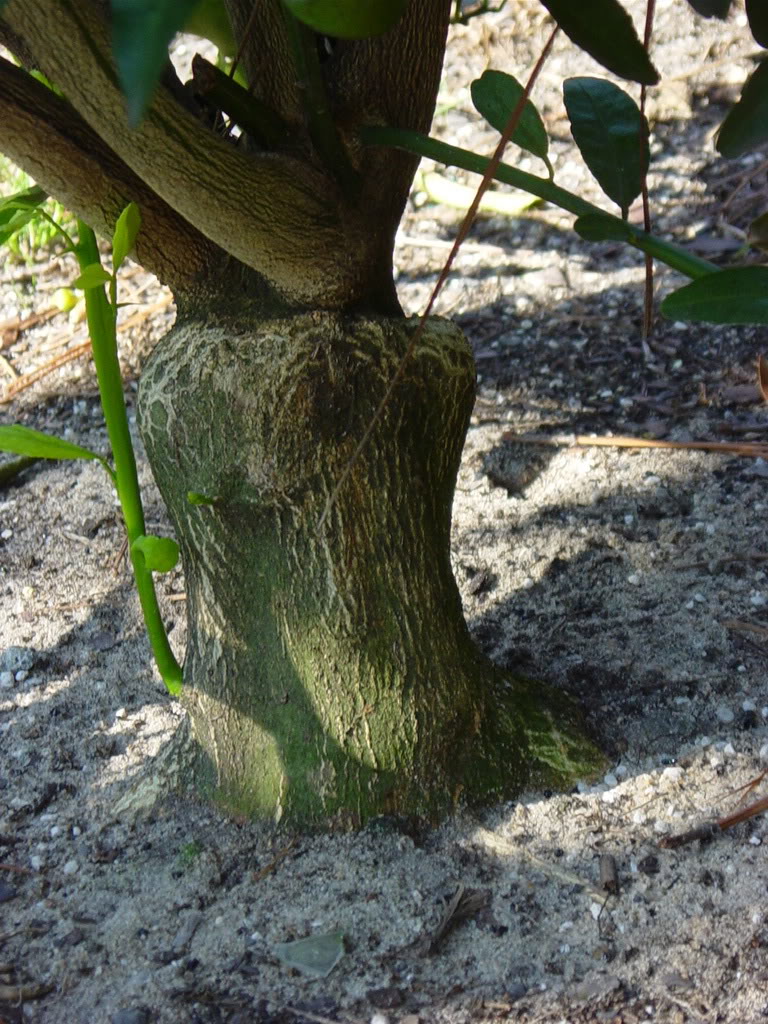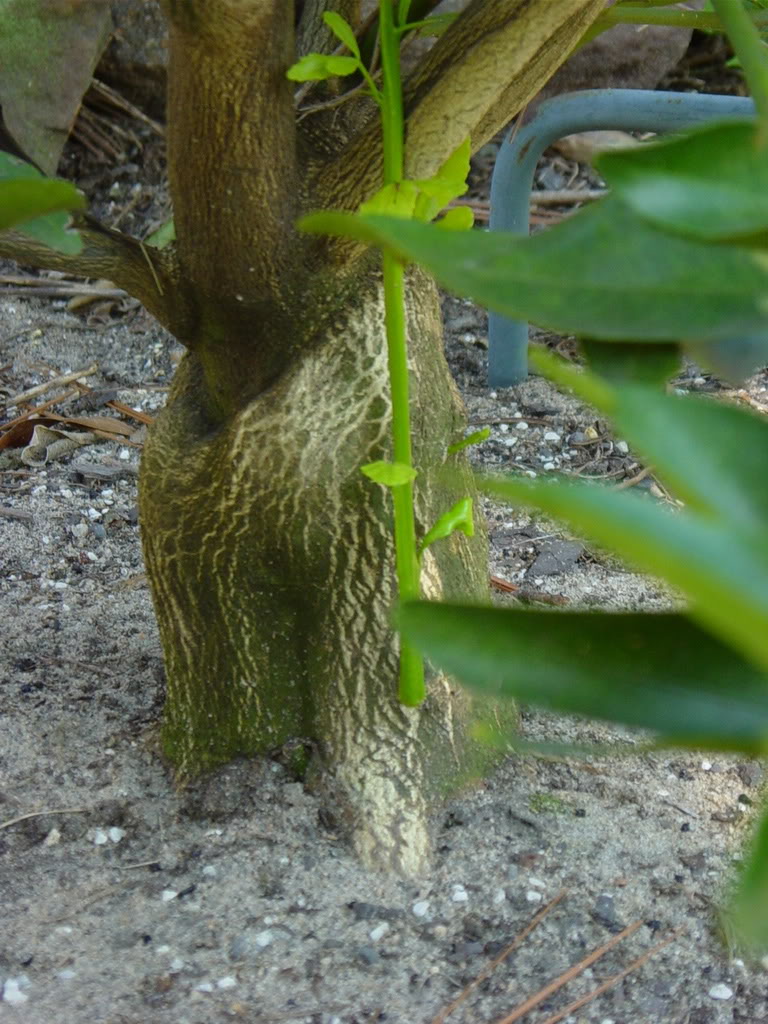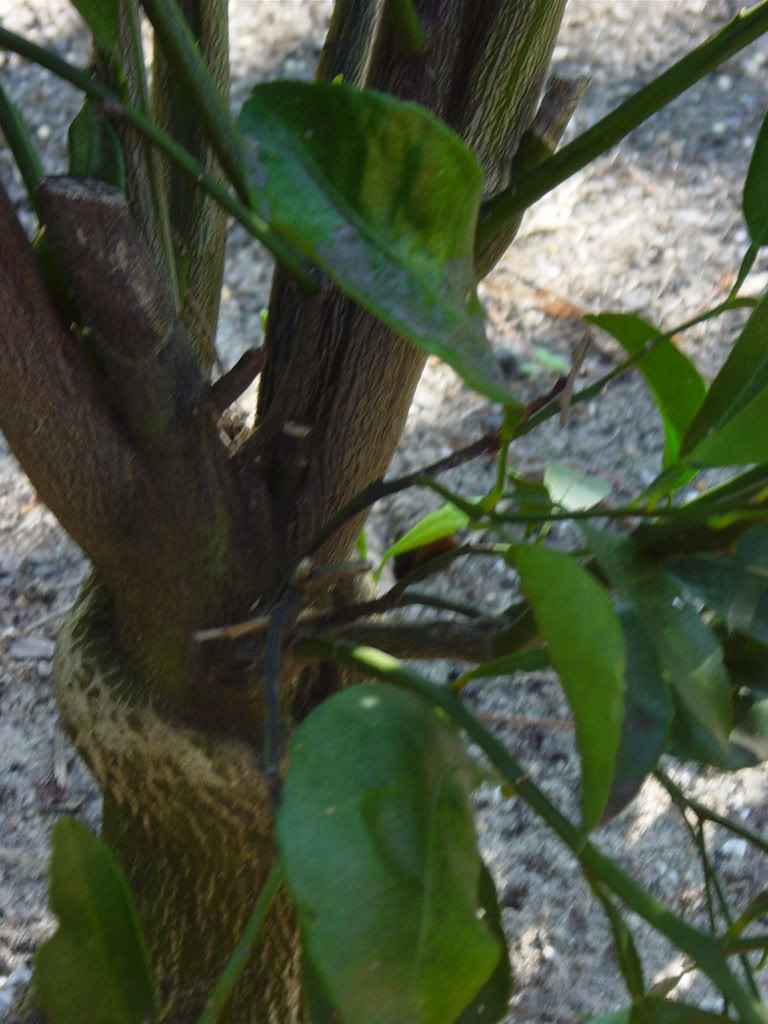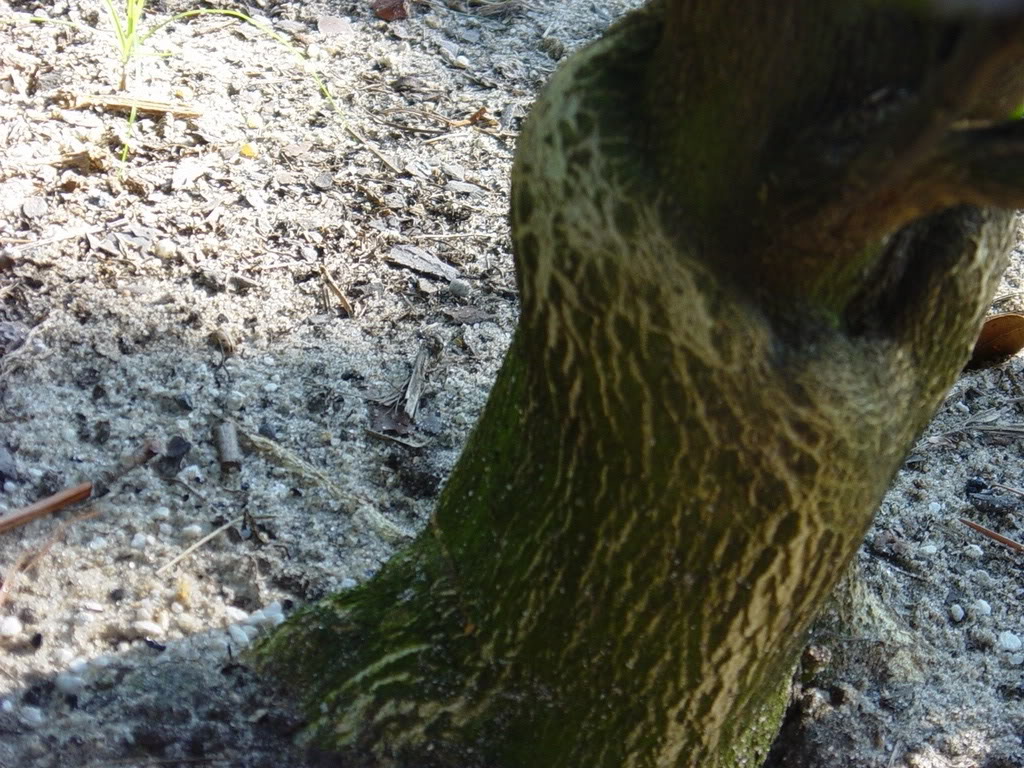 |
Citrus Growers Forum
This is the read-only version of the Citrus Growers Forum.
Breaking news: the Citrus Growers Forum is reborn from its ashes!
Citrus Growers v2.0
|
|
|
|
| Author |
Message |
Skeeter
Moderator

Joined: 23 Jul 2006
Posts: 2218
Location: Pensacola, FL zone 9
|
| Posted: Fri 28 Sep, 2007 12:24 pm |
|
I just want to make sure I understand the term "benching"-- is that when the rootstock tree grows faster (in diameter) than the scion?
Does that always lead to death of the scion at some time later (like 15 to 20 yrs)?
Is there anything that can be done (like inarching)?
The reason I ask is because the Ponkan I have (on some type of trifoliate) is beginning to develop significantly different trunk sizes.
_________________
Skeet
 |
|
| Back to top |
|
 |
Steve
Citruholic

Joined: 10 Sep 2007
Posts: 253
Location: Southern Germany
|
| Posted: Fri 28 Sep, 2007 7:17 pm |
|
Dear Skeeter,
first don't panic 
Benching is simply the term or description for a stronger growth of the rootstock than the scion.
It's usually typical for scions grafted to Poncirus trifoliata and it's hybrids.
The bench is formed like a bottle neck, and if smooth and not to sharp usually the tree will do longer than 20 years.
But often it was found, tha if the bench is to flatt, and the scion diameter will not follow proberly, that many of these things were not long living.
Same when cracks appear, or the rootstocj grows upwards, forming a bulge which swaps over the scion upwards, showing a typical sign of incompatibily.
In Leons you have to opposite of the Poncirus trifoliata benching effect.
Lemon in the mediterran where grafted usually to Citrus aurantium, because even in areas with high tristeza pressure those combinations do not die, as Citrus aurantium does not die after CTV infection, if grown on it's own roots.
But Lemons on Sour Orange overgrow the rootstock. It starts with a bulge of the scion at the graft union, starting with a thicker scion and a bench is formed, and at least a strong bulge starts overgrowing of the rootstock, but what else is considered as hard sign of incompatibility, is here typical for Lemons on this stock, and the strong overgrowth will not lead to heavy problems, and will not lead to tree suffer. This combination will endure very long....
Hope it was understandable and helpfull
_________________
Eerh, hmm, uuuh, oooh, just guessing  |
|
| Back to top |
|
 |
Skeeter
Moderator

Joined: 23 Jul 2006
Posts: 2218
Location: Pensacola, FL zone 9
|
| Posted: Fri 28 Sep, 2007 10:50 pm |
|
That confirms what I thought "benching" means. The tree in question is only about 4 years old, but there is already a significant difference in the size of the trunks-- the rootstock has not started to overgrow the scion yet, but does it always end that way? Or is there something that can be done.
Does this have anything to do with the fact that the tree had a bad case of sooty canker 2 years ago and I had to cut the center stem off about 6 inches above the graft?
_________________
Skeet
 |
|
| Back to top |
|
 |
Malcolm_Manners
Citrus Guru

Joined: 13 Nov 2005
Posts: 676
Location: Lakeland Florida
|
| Posted: Sat 29 Sep, 2007 1:10 pm |
|
Trees on 'Swingle' citrumelo make a very marked bench, and so far as we can tell, after more than 30 years of using that rootstock, the trees are no less long-lived than they would be on any other rootstock, bench or not. |
|
| Back to top |
|
 |
JoeReal
Site Admin


Joined: 16 Nov 2005
Posts: 4726
Location: Davis, California
|
| Posted: Sat 29 Sep, 2007 1:29 pm |
|
One of the original questions is
Can inarching or bridge grafting prolong the life or repair the effects of benching?
The follow up question is
Why not?
And my recommendation is:
So go ahead and try it...
What have we got to lose when there is something to gain, at least in the results, whatever that may be. |
|
| Back to top |
|
 |
Millet
Citruholic


Joined: 13 Nov 2005
Posts: 6657
Location: Colorado
|
| Posted: Sat 29 Sep, 2007 3:13 pm |
|
.............Can inarching or bridge grafting prolong the life or repair the effects of benching...............
Certainly would not hurt, however, there is probably no need for inarching or bridge grafting. - Millet |
|
| Back to top |
|
 |
JoeReal
Site Admin


Joined: 16 Nov 2005
Posts: 4726
Location: Davis, California
|
| Posted: Sat 29 Sep, 2007 3:36 pm |
|
Millet,
Have you read the various summary of rootstock trials that was posted by Jim (Snickles)? There are various pictures as to how the benching has impeded the translocation of starches, sugars, and thus most probably causing the decline, which I think can be circumvented by bridge grafting or inarching. So in my opinion, there is tremendous merit to overcoming the translocation problems brought about by benching. Just a thought. Doesn't hurt to try it in real life and there is knowledge to be gain, if it worked or not.
If it works, it could benefit the hobbyist the most and other home growers with those objectives of prolonging existing trees, but for commercial growers, that might be another do or die cost issue added to production.
Joe |
|
| Back to top |
|
 |
Ned
Citrus Guru

Joined: 14 Nov 2005
Posts: 999
Location: Port Royal, SC (Zone 8b)
|
| Posted: Sat 29 Sep, 2007 6:26 pm |
|
This is a picture I took a while back of Orlando on Swingle. It clearly shows the difference in size between the rootstock and scion, which will only become more pronounced with age.
Ned
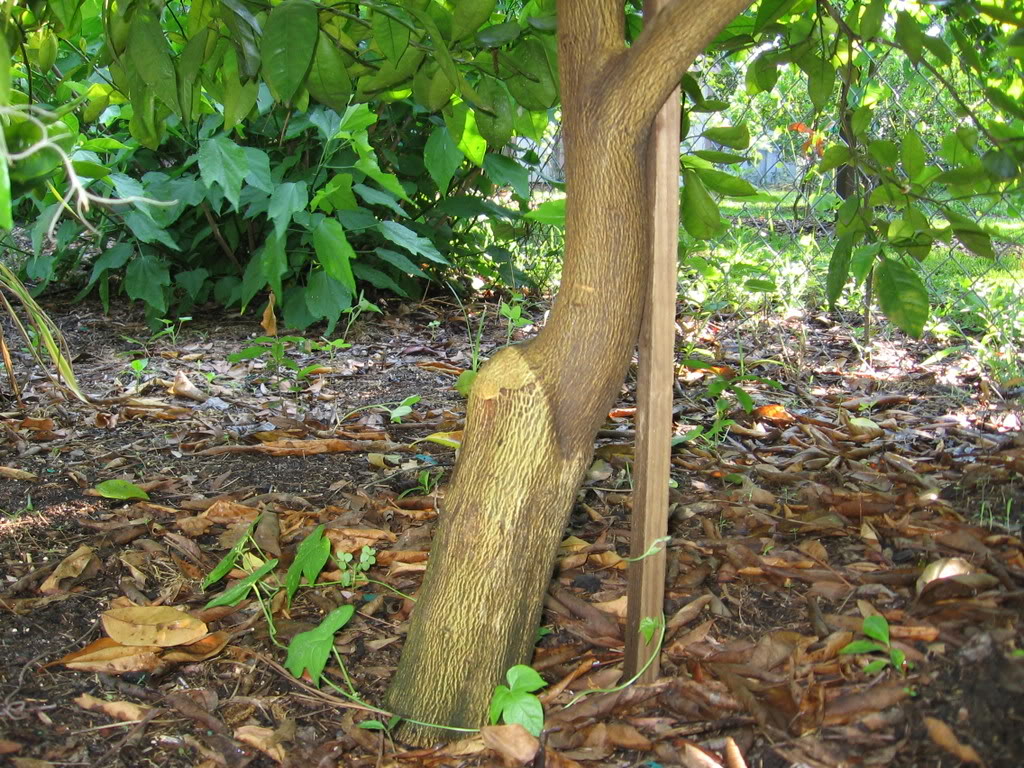 |
|
| Back to top |
|
 |
Steve
Citruholic

Joined: 10 Sep 2007
Posts: 253
Location: Southern Germany
|
| Posted: Sat 29 Sep, 2007 7:08 pm |
|
Thanks,
for the very good picture.
The benching is not so pronounced as often seen, but clearly visible. But at the trunk base of the stock, one can also spot the typical 'Fluting' of the most trifoliate rootstocks, or plants as well. Mostly visible an older Poncirus trifoliata trees, were the fluting is very minted, as mostly strong folds or bulges are found. This is only expressed by those stocks that way...
So even here good visible.
_________________
Eerh, hmm, uuuh, oooh, just guessing  |
|
| Back to top |
|
 |
Skeeter
Moderator

Joined: 23 Jul 2006
Posts: 2218
Location: Pensacola, FL zone 9
|
| Posted: Sun 30 Sep, 2007 12:03 am |
|
I will try to get a picture of the tree tomorrow-- it is definitly more pronounced than the one pictured, probably not at the stage of cutting off any nutrients, but having read that it could cause the tree to die after some time due to the benching, I thought I would ask about it.
I may try the inarching just to learn if nothing else, and my thoughts were taht if the ultimate decline is due to reduced flow of nutrients, then that should help.
I am guessing that it would not matter if I used a different rootstock for the inarching-- the only thing I have right now is FD and some marcotted trifoliate. I may be able to get a rooted piece of another rootstock from my wife's dad-- he is here in FL and has 2 kumquats that are on different rootstocks. I just cut the rootstock sprouts off a month ago-- one was trifoliate, but the other had a single leaf like an orange-- other than that, I did not pay much attention to it.
_________________
Skeet
 |
|
| Back to top |
|
 |
Millet
Citruholic


Joined: 13 Nov 2005
Posts: 6657
Location: Colorado
|
| Posted: Sun 30 Sep, 2007 1:41 am |
|
Last spring in Riverside, California, Citrus Joe and I visited what probably is the worlds most famous inarched citrus tree. It was Luther and Eliza Tibbets's Mother Navel Orange tree. Budstock from this tree created the beginnings of wholesale citrus production in California, and are the "roots" of the 100 plus-year-old Sunkist cooperative. - Millet |
|
| Back to top |
|
 |
citrange
Site Admin


Joined: 24 Nov 2005
Posts: 590
Location: UK - 15 miles west of London
|
| Posted: Sun 30 Sep, 2007 7:56 am |
|
I hadn't heard of the term 'benching' - I always just called it 'overgrowth' of the rootstock or of the scion.
I have a couple of citrus that show this clearly.
The first picture is a Nagami Kumquat about 30years old, bought from Four Winds Nusery, so presumably on Flying Dragon rootstock. The rootstock is about 2" in diameter.
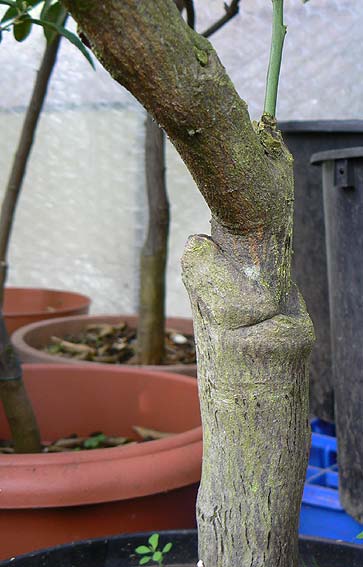
The second picture shows an unknown variegated citron variety growing on, I think, Rough Lemon. This is about 8 years old and the rootstock about half an inch in diameter.
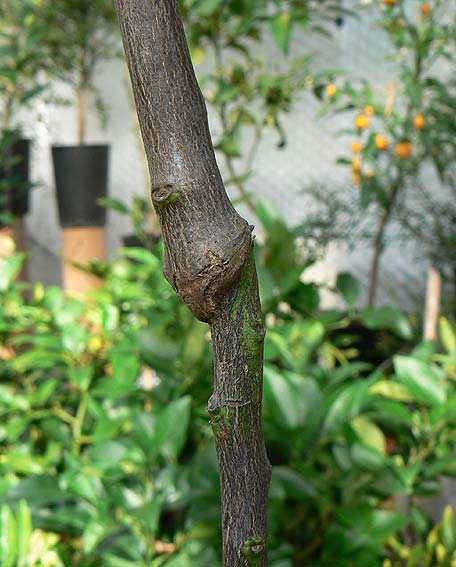
For the moment, neither plant shows any particular sign of problems due to the benching (or overgrowth). |
|
| Back to top |
|
 |
Ned
Citrus Guru

Joined: 14 Nov 2005
Posts: 999
Location: Port Royal, SC (Zone 8b)
|
| Posted: Sun 30 Sep, 2007 10:25 am |
|
I have inarched an Ambersweet orange to help with a case of foot rot. It was easy, as both the new rootstocks and the scion were sustained by existing roots. I simply cut an inverted T in the scion and a long slanting cut on the rootstock, and taped it up good. You do have to be careful about watering, as (in my case at least) the tree will keep overhead water from reaching the new rootstock. If the bark of the scion is not slipping, or is too thick, you might have to use something besides the inverted T to make the attachment, but the bark on my tree separated surprisingly easily. I intend to add a few more rootstocks this fall.
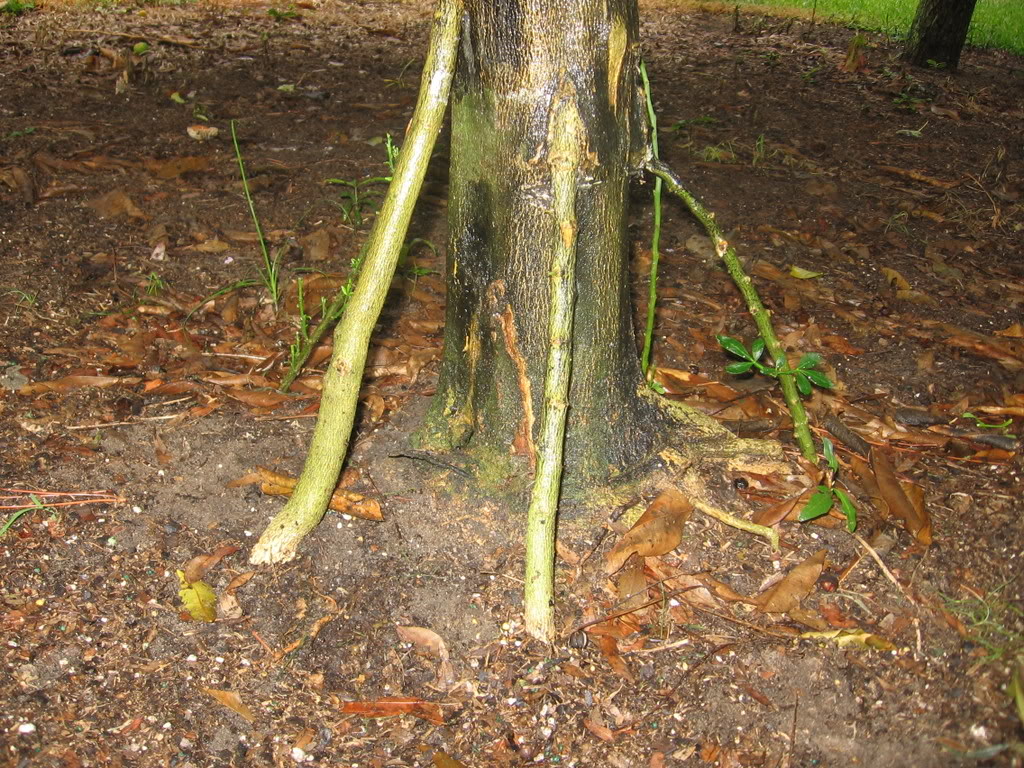 |
|
| Back to top |
|
 |
Skeeter
Moderator

Joined: 23 Jul 2006
Posts: 2218
Location: Pensacola, FL zone 9
|
| Posted: Sun 30 Sep, 2007 12:30 pm |
|
_________________
Skeet
 |
|
| Back to top |
|
 |
Steve
Citruholic

Joined: 10 Sep 2007
Posts: 253
Location: Southern Germany
|
| Posted: Sun 30 Sep, 2007 5:30 pm |
|
Hi Skeet,
well, you can inarch, if you feel better..
But from my opinion, the tree does not look very dramatic at the bud union, the benching is hard, yes, but it seems not harmfull for the tree, as I think the bun-union is quite well...
But if you think, inarching will help the tree...
_________________
Eerh, hmm, uuuh, oooh, just guessing  |
|
| Back to top |
|
 |
| Informations |
 |
Our users have posted a total of 66068 messages
We have 3235 registered members on this websites
|
| Most users ever online was 70 on Tue 30 Oct, 2012 10:12 am |
Powered by phpBB © 2001, 2005 phpBB Group
|
|














